Modelling Small-Scale Storage Interventions in Semi-Arid India at the Basin Scale
Abstract
1. Introduction
- The hydrological functioning of each type of intervention is uncertain.
- Proxy values and parameter adjustments have been utilised in an attempt to quantify the functioning of interventions.
- Data on the location and characteristics of interventions are scarce and not well documented when available.
2. Materials and Methods
2.1. Site Description
2.2. Model Development
2.2.1. Groundwater Routine
2.2.2. Conceptualisation of Interventions
- Urban and Rural Tanks
- Check Dams
- Farm Bunds
2.3. Model Application
- All interventions (tanks, check dams and farm bunds)
- No interventions
- Only tanks
- Only check dams
- Only farm bunds
2.4. Model Calibration and Validation
2.5. Data Acquisition
3. Results
3.1. Model Performance
3.2. Sensitivity Analysis of Interventions within GWAVA
3.2.1. Tanks
3.2.2. Check Dams
3.2.3. Farm Bunds
3.3. Effect of Interventions in the Cauvery
4. Discussion
5. Conclusions
- Conceptualised interventions play an important part in the allocation and better representation of simulated surface water within the basin.
- The effect of the conceptualised interventions within GWAVA is dependent on the hydrogeology of the modelled sub-catchment, as well as the simulated groundwater level.
- The influence of the interventions is greater on the simulated streamflow in the wet years and on estimated evaporation in the dry years.
- Farm bunds provide an effective method for reducing the pressure of canal irrigation and groundwater pumping in agricultural areas.
Author Contributions
Funding
Institutional Review Board Statement
Informed Consent Statement
Data Availability Statement
Conflicts of Interest
Appendix A
| Scenario | Depth (m) | Width (m) | Intervention Density (m3/ha) | Scenario | Depth (m) | Width (m) | Intervention Density (m3/ha) |
|---|---|---|---|---|---|---|---|
| Tanks | |||||||
| T1 | 3 | n/a | 25 | T7 | 5 | n/a | 125 |
| T2 | 3 | n/a | 75 | T8 | 5 | n/a | 200 |
| T3 | 3 | n/a | 125 | T9 | 10 | n/a | 25 |
| T4 | 3 | n/a | 200 | T10 | 10 | n/a | 75 |
| T5 | 5 | n/a | 25 | T11 | 10 | n/a | 125 |
| T6 | 5 | n/a | 75 | T12 | 10 | n/a | 200 |
| Check Dams | |||||||
| C1 | 1 | 7 | 25 | C7 | 1.5 | 10 | 125 |
| C2 | 1 | 7 | 75 | C8 | 1.5 | 10 | 200 |
| C3 | 1 | 7 | 125 | C9 | 2 | 15 | 25 |
| C4 | 1 | 7 | 200 | C10 | 2 | 15 | 75 |
| C5 | 1.5 | 10 | 25 | C11 | 2 | 15 | 125 |
| C6 | 1.5 | 10 | 75 | C12 | 2 | 14 | 200 |
| Farm Bunds | |||||||
| B1 | 0.03 | n/a | 25 | B5 | 0.06 | n/a | 25 |
| B2 | 0.03 | n/a | 75 | B6 | 0.06 | n/a | 75 |
| B3 | 0.03 | n/a | 125 | B7 | 0.06 | n/a | 125 |
| B4 | 0.03 | n/a | 200 | B8 | 0.06 | n/a | 200 |
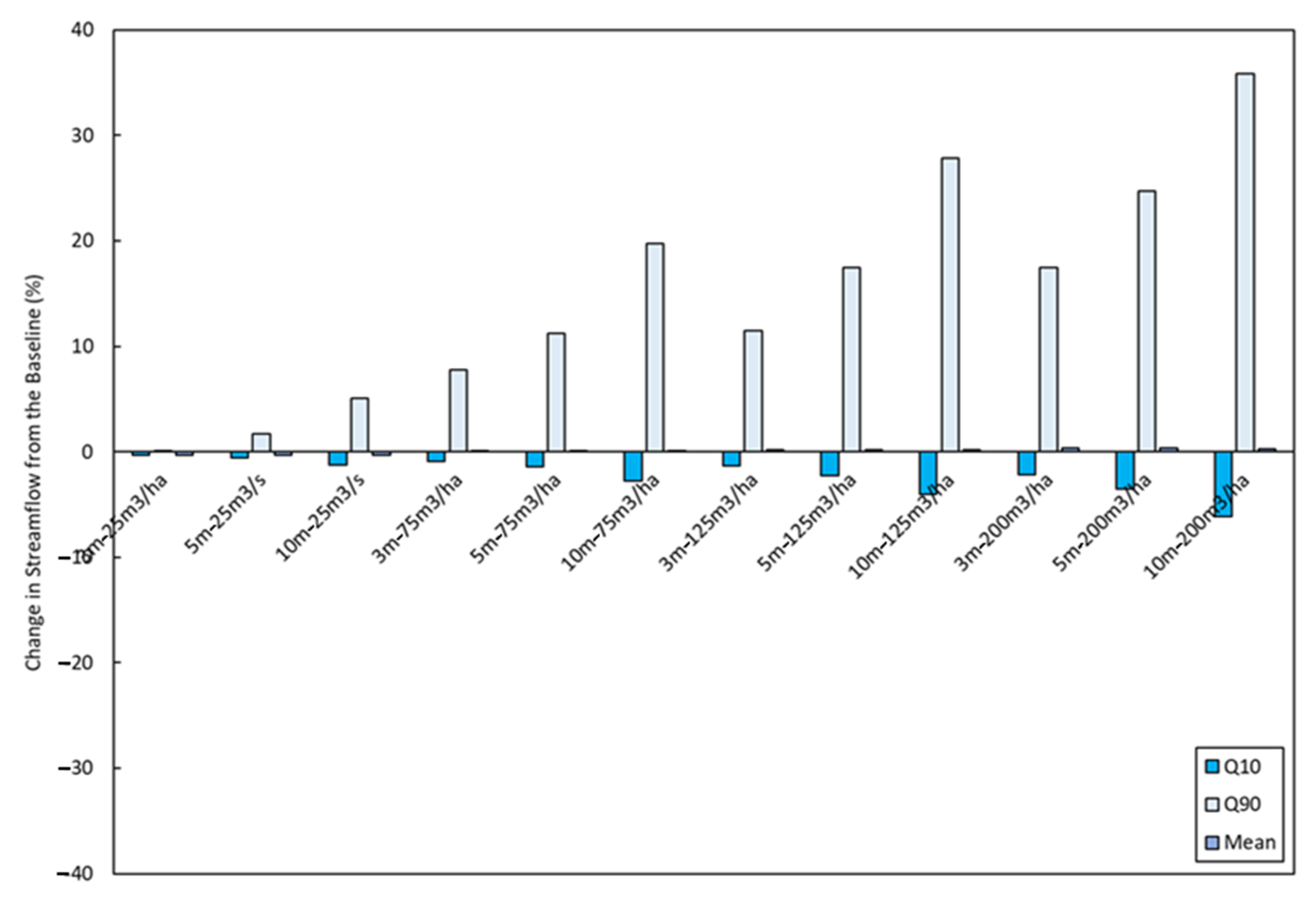

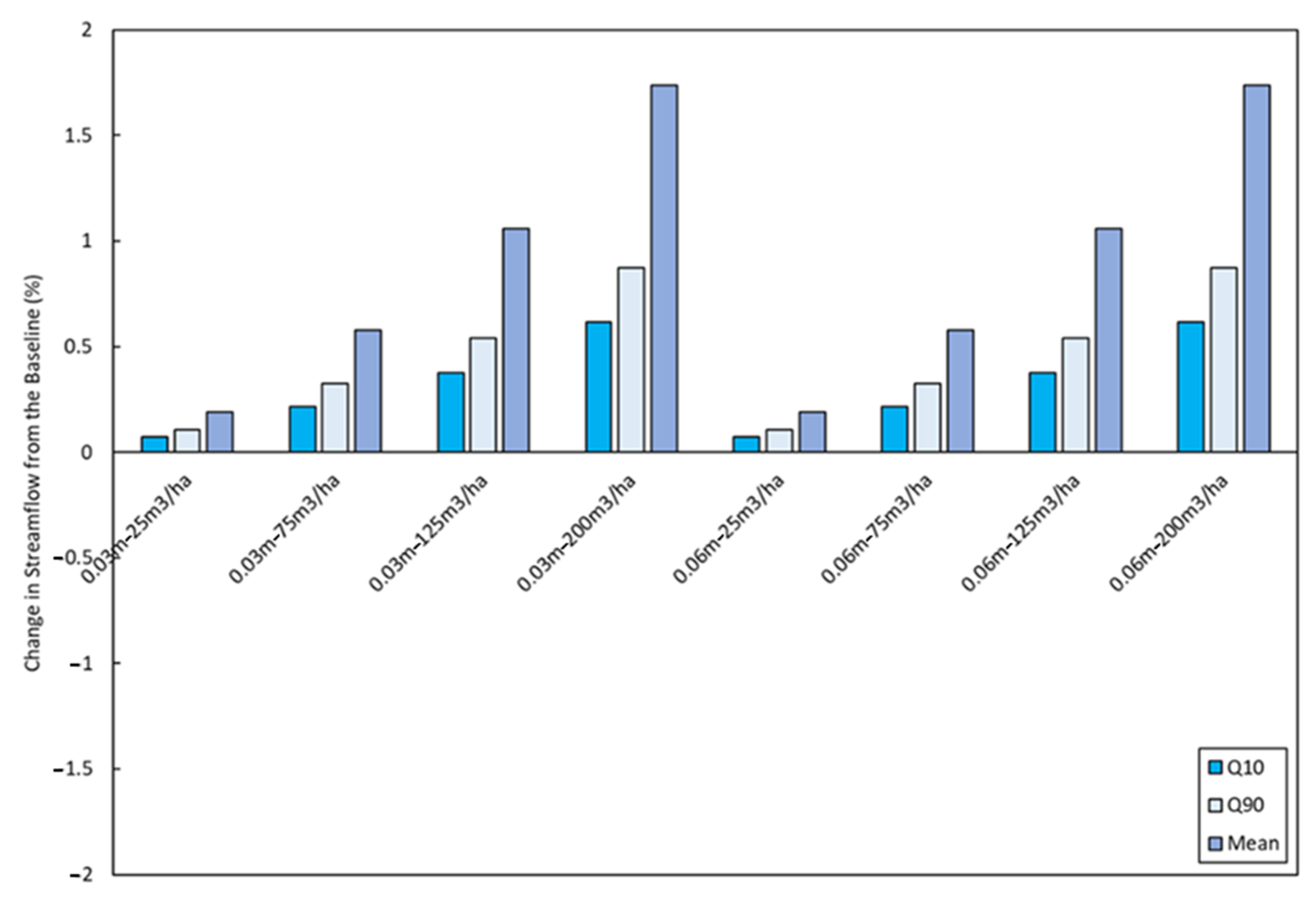
Appendix B
| Sub-Catchment | Calibration | Validation | |||||
|---|---|---|---|---|---|---|---|
| KGE without Interventions | KGE with Interventions | Period | KGE without Interventions | KGE with Interventions | Period | ||
| a | Saklesphur | 0.53 | 0.66 | 2006–2010 | 0.37 | 0.38 | 2010–2013 |
| b | Thimmanahali | 0.71 | 0.71 | 2005–2009 | 0.72 | 0.68 | 2010–2013 |
| c | KMVadi | 0.25 | 0.24 | 1991–2000 | 0.16 | 0.16 | 2001–2011 |
| d | Kudige | 0.48 | 0.59 | 1990–2000 | 0.55 | 0.59 | 2012–2014 |
| e | Munthankera | 0.73 | 0.82 | 1990–2000 | 0.66 | 0.70 | 2001–2011 |
| f | Tbekuppe | 0.41 | 0.32 | 1980–1990 | −1.28 | −1.27 | 2001–2003 |
| g | TKHali | 0.52 | 0.71 | 1990–2000 | 0.69 | 0.67 | 2001–2008 |
| h | T Narasupiar | 0.60 | 0.68 | 1988–1998 | 0.25 | 0.30 | 1999–2002 |
| i | Kollegal | 0.56 | 0.58 | 2008–2011 | 0.50 | 0.54 | 2012–2013 |
| j | Bilingudulu | 0.74 | 0.74 | 1990–2000 | 0.61 | 0.60 | 2001–2011 |
| k | Urachikottai | 0.34 | 0.74 | 1990–2000 | 0.49 | 0.51 | 2001–2008 |
| l | Kodumodi | 0.25 | 0.62 | 1990–2000 | 0.24 | 0.30 | 2005–2010 |
| o | Musiri | 0.33 | 0.65 | 1990–2000 | 0.43 | 0.44 | 2006–2010 |
| m | Thengumarahada | 0.57 | 0.50 | 1990–2000 | 0.39 | 0.44 | 2001–2008 |
Appendix C
| Input Data | Spatial Resolution | Temporal Resolution | Time Period | Source |
|---|---|---|---|---|
| Precipitation | 0.25 degree | Daily | 1951–2017 | Indian Meteorological Department [73] |
| Maximum Temperature | 0.25 degree | Daily | 1951–2016 | Indian Meteorological Department [73] |
| Minimum Temperature | 0.25 degree | Daily | 1951–2016 | Indian Meteorological Department [73] |
| Open Water Evaporation | India | Monthly | 1959–1968 | Central Water Commission, Basin Planning & Management Organisation [53] |
| Streamflow gauged data | Cauvery Basin | Daily | 1971–2014 | India-WRIS |
| Reservoir inflow and outflow data | Cauvery Basin | Monthly | 1974–2017 | India-WRIS |
| Water transfers | Cauvery Basin | Ashoka Trust for Research in Ecology and the Environment (ATREE) | ||
| Tanks | Cauvery Basin | 2019 | Waterbodies dataset [71] | |
| Check dams | Karnataka (District) | 2006–2012 | Structural Investment Report, Watershed Development Department | |
| Farm bunds | Karnataka (District) | 2006–2012 | Structural Investment Report, Watershed Development Department | |
| Elevation | 0.003 degree | 2000 | NASA Shuttle Radar Mission Global 1 arc second V003 [81] | |
| Soil type | 0.008 degree | 1971–1981 | Harmonized World Soil Database v1.2 [82] | |
| Land Cover Land Use | 0.001 degree | 2005 | Decadal land use and land cover across India 2005 [83] | |
| Crops | Cauvery Basin (Taluk *) | 2000 | National Remote Sensing Centre (NRSC) | |
| Total Population | Cauvery Basin (Village) | 2011 | Indian Decadal Census | |
| Rural Population | Cauvery Basin (Village) | 2011 | Indian Decadal Census | |
| Livestock | 0.05 degree | 2005 | CGIR Livestock of the World v2 [84] |
Appendix D

| Year | P (mm) | Q-int (mm) | Q-no int (mm) | ∆Q (%) | ET-int (mm) | ET-no int (mm) | ∆ET (%) | Aq-int (m) | Aq-no int (m) | ∆Aq (m) | |
|---|---|---|---|---|---|---|---|---|---|---|---|
| S1 | 1998 | 507 | 118 | 130 | −9.4 | 624 | 602 | 3.4 | 14.02 | 14.42 | 2.7 |
| 2002 | 382 | 44 | 48 | −8.8 | 436 | 421 | 3.4 | 12.46 | 12.86 | 3.1 | |
| 2005 | 668 | 68 | 75 | −8.6 | 735 | 708 | 3.6 | 14.52 | 14.92 | 2.6 | |
| S2 | 1998 | 1874 | 977 | 1020 | −4.2 | 1527 | 1485 | 2.7 | 12.61 | 12.61 | 0 |
| 2002 | 656 | 669 | 704 | −5 | 489 | 477 | 2.5 | 12.64 | 12.64 | 0 | |
| 2005 | 2085 | 802 | 840 | −4.5 | 1301 | 1262 | 3 | 12.32 | 12.32 | 0 | |
| Outlet | 1998 | 1341 | 325 | 334 | −2.6 | 1030 | 928 | 9.9 | 8.97 | 9 | 0.2 |
| 2002 | 685 | 130 | 134 | −2.6 | 521 | 469 | 9.9 | 8.97 | 8.99 | 0.3 | |
| 2005 | 1413 | 432 | 446 | −3.1 | 1067 | 962 | 9.8 | 8.95 | 8.96 | 0.1 |
References
- Cleaver, F. Development through Bricolage. Rethinking Institutions for Natural Resource Management; Routledge: Abingdon, UK, 2017. [Google Scholar]
- Loucks, D.P. Managing water as a critical component of a changing world. Water Resour. Manag. 2017, 31, 2905–2916. [Google Scholar] [CrossRef]
- Wang, X.J.; Zhang, J.Y.; Shahid, S.; Guan, E.H.; Wu, Y.X.; Gao, J.; He, R.M. Adaptation to climate change impacts on water demand. Mitig. Adapt. Strateg. Glob. Chang. 2016, 21, 81–99. [Google Scholar] [CrossRef]
- Smith, Z.A. Competition for Water Resources. Issues in Federalism. Fla. State Univ. J. Land Use Environ. Law 2018, 2, 3–10. [Google Scholar]
- Ramaswamy, S. The groundwater recharge movement in India. In The Agricultural Groundwater Revolution. Opportunities and Threats to Development; CABI: Wallingford, UK, 2007. [Google Scholar]
- Goyal, M.R.; Sivanappan, R.K. Engineering Practices for Agricultural Production and Water Conservation. An Interdisciplinary Approach. Oakville; Apple Academic Press: Palm Bay, FL, USA, 2017. [Google Scholar]
- Agoramoorthy, G.; Hsu, M.J. Small size, big potential. check dams for sustainable development. Environ. Sci. Policy Sustain. Dev. 2008, 50, 22–35. [Google Scholar] [CrossRef]
- Renganayaki, S.P.; Elango, L. A review on managed aquifer recharge by check dams. A case study near Chennai, India. Int. Reserv. Eng. Technol. 2013, 2, 416–423. [Google Scholar]
- Shah, T. India’s master plan for groundwater recharge. An assessment and some suggestions for revision. Econ. Political Wkly. 2008, 20, 41–49. [Google Scholar]
- Van Meter, K.J.; Basu, N.B.; McLaughlin, D.L.; Steiff, M. The socio-ecohydrology of rainwater harvesting in India. Understanding water storage and release dynamics at tank and catchment scales. Hydrol. Earth Syst. Sci. Diss. 2015, 12, 12121–12165. [Google Scholar]
- Xu, Y.D.; Fu, B.J.; He, C.S. Assessing the hydrological effect of the check dams in the Loess Plateau, China, by model simulations. Hydrol. Earth Syst. Sci. 2013, 17, 2185. [Google Scholar] [CrossRef]
- Vidya, V.K.; Putty, Y.; Mysooru, R.; Manjunath, K.C. Urban Tanks for Facilitating Reuse of Municipal Sewage—A Case Study in Mysuru, Karnataka. Aquat. Procedia 2015, 4, 1508–1513. [Google Scholar] [CrossRef]
- Garg, K.K.; Karlberg, L.; Barron, J.; Wani, S.P.; Rockstrom, J. Assessing impacts of agricultural water interventions in the Kothapally watershed, Southern India. Hydrol. Process. 2012, 26, 387–404. [Google Scholar] [CrossRef]
- Penny, G.; Srinivasan, V.; Dronova, I.; Lele, S.; Thompson, S. patial characterization of long-term hydrological change in the Arkavathy watershed adjacent to Bangalore, India. Hydrol. Earth Syst. Sci. 2018, 22, 595–610. [Google Scholar] [CrossRef]
- Doolittle, W.E. The use of check dams for protecting downstream agricultural lands in the prehistoric Southwest. a contextual analysis. J. Anthropol. Res. 1985, 41, 279–305. [Google Scholar] [CrossRef]
- Armanini, A.; Dellagiacoma, F.; Ferrari, L. From the check dam to the development of functional check dams. In Fluvial Hydraulics of Mountain Regions; Springer: Berlin/Heidelberg, Germany, 1991. [Google Scholar]
- Boix-Fayos, C.; Barberá, G.G.; López-Bermúdez, F.; Castillo, V.M. Effects of check dams, reforestation and land-use changes on river channel morphology. Case study of the Rogativa catchment (Murcia, Spain). Geomorphology 2007, 91, 103–123. [Google Scholar] [CrossRef]
- Boix-Fayos, C.; de Vente, J.; Martínez-Mena, M.; Barberá, G.G.; Castillo, V. The impact of land use change and check-dams on catchment sediment yield. Hydrol. Process. Int. J. 2008, 22, 4922–4935. [Google Scholar] [CrossRef]
- Mishra, A.; Froebrich, J.; Gassman, P.W. Evaluation of the SWAT model for assessing sediment control structures in a small watershed in India. Trans. ASABE 2007, 50, 469–477. [Google Scholar] [CrossRef]
- Polyakov, V.O.; Nichols, M.H.; McClaran, M.P.; Nearing, M.A. Effect of check dams on runoff, sediment yield, and retention on small semiarid watersheds. J. Soil Water Conserv. 2014, 69, 414–421. [Google Scholar] [CrossRef]
- Dashora, Y.; Dillon, P.; Maheshwari, B.; Soni, P.; Dashora, R.; Davande, S.; Purohit, R.C.; Mittal, H.K. A simple method using farmers’ measurements applied to estimate check dam recharge in Rajasthan, India. Sustain. Water Resour. Manag. 2018, 4, 301–316. [Google Scholar] [CrossRef]
- Wei, Y.; He, Z.; Li, Y.; Jiao, J.; Zhao, G.; Mu, X. Sediment yield deduction from check-dams deposition in the weathered sandstone watershed on the North Loess Plateau, China. Land Degrad. Dev. 2017, 28, 217–231. [Google Scholar] [CrossRef]
- Díaz-Gutiérrez, V.; Mongil-Manso, J.; Navarro-Hevia, J.; Ramos-Díez, I. Check dams and sediment control. final results of a case study in the upper Corneja River (Central Spain). J. Soils Sediments 2019, 19, 451–466. [Google Scholar] [CrossRef]
- Krois, J.; Schulte, A. Modeling the hydrological response of soil and water conservation measures in the Ronquillo watershed in the Northern Andes of Peru. In Proceedings of the 6th International Conference on Water Resources and Environment Research, Koblenz, Germany, 3–7 June 2013; pp. 147–184. [Google Scholar]
- Salman, S.M. Inter-states water disputes in India. an analysis of the settlement process. Water Policy 2002, 4, 223–237. [Google Scholar] [CrossRef]
- Sreelash, K.; Mathew, M.M.; Nisha, N.; Arulbalaji, P.; Bindu, A.G.; Sharma, R.K. Changes in the Hydrological Characteristics of Cauvery River draining the eastern side of southern Western Ghats, India. Int. J. River Basin Manag. 2020, 18, 153–166. [Google Scholar] [CrossRef]
- Sharma, A.; Hipel, K.W.; Schweizer, V. Strategic Insights into the Cauvery River Dispute in India. Sustainability 2020, 12, 1286. [Google Scholar] [CrossRef]
- Hoekstra, A.Y.; Mekonnen, M.M.; Chapagain, A.K.; Mathews, R.E.; Richter, B.D. Global monthly water scarcity. blue water footprints versus blue water availability. PLoS ONE 2012, 7, e32688. [Google Scholar] [CrossRef]
- Moore, R.J. The Probability- Distrubuted Principal and Runoff Production at Point and Basin Scales. Hydrol. Sci. J. 1985, 30, 273–297. [Google Scholar] [CrossRef]
- Falkenmark, M.; Molden, D. Wake up to realities of river basin closure. Int. J. Water Resour. Dev. 2008, 24, 201–215. [Google Scholar] [CrossRef]
- Bhave, A.G.; Conway, D.; Dessai, S.; Stainforth, D.A. Water resource planning under future climate and socioeconomic uncertainty in the Cauvery River Basin in Karnataka, India. Water. Res. Res. 2018, 52, 708–728. [Google Scholar] [CrossRef]
- Jamwal, P.; Thomas, B.K.; Lele, S.; Srinivasan, V. Addressing water stress through wastewater reuse. Complexities and challenges in Bangalore, India. In Proceedings of the Resilient Cities 2014 Congress, Bonn, Germany, 29–31 May 2014. [Google Scholar]
- Kumar, M.D.; Ghosh, S.; Patel, A.; Singh, O.P.; Ravindranath, R. Rainwater harvesting in India. some critical issues for basin planning and research. Land Use Water Resour. Res. 2006, 6, 1–17. [Google Scholar]
- Patel, S.S.; Ramachandran, P. A comparison of machine learning techniques for modeling river flow time series. the case of upper Cauvery river basin. Water. Res. Manag. 2015, 29, 589–602. [Google Scholar] [CrossRef]
- Kumar, R.; Nandagiri, L. Application and Test of the SWAT Model in the Upper Cauvery River Basin, Karnataka, India. In Proceedings of the 4th International Engineering Symposium Proceedings, Kumamoto, Japan, 23–24 May 2015. [Google Scholar]
- Gosain, A.K.; Rao, S.; Basuray, D. Climate change impact assessment on hydrology of Indian river basins. Curr. Sci. 2006, 90, 346–353. [Google Scholar]
- Singh, A.; Gosain, A.K. Climate-change impact assessment using GIS-based hydrological modelling. Water Int. 2011, 36, 386–397. [Google Scholar] [CrossRef]
- Bhuvaneswari, K.; Geethalakshmi, V.; Lakshmanan, A.; Srinivasan, R.; Sekhar, N.U. The impact of El Nino/Southern oscillation on hydrology and rice productivity in the Cauvery Basin, India. application of the soil and water assessment tool. Weather Clim. Extrem. 2013, 2, 39–47. [Google Scholar] [CrossRef]
- Mandal, U.; Sahoo, S.; Munusamy, S.B. Delineation of groundwater potential zones of coastal groundwater basin using multi-criteria decision making technique. Water Resour. Manag. 2016, 30, 4293–4310. [Google Scholar] [CrossRef]
- Geetha, K.; Mishra, S.K.; Eldho, T.I.; Rastogi, A.K.; Pandey, R.P. SCS-CN-based continuous simulation model for hydrologic forecasting. Water Resour. Manag. 2008, 22, 165–190. [Google Scholar] [CrossRef]
- Parvez, M.B.; Inayathulla, M. Estimation of Surface Runoff by Soil Conservation Service Curve Number Model for Upper Cauvery Karnataka. Int. J. Sci. Res. Multidiscip. Stud. 2019, 5, 7–17. [Google Scholar]
- Raje, D.; Priya, P.; Krishnan, R. Macroscale hydrological modelling approach for study of large scale hydrologic impacts under climate change in Indian river basins. Hydrol. Process. 2014, 28, 1874–1889. [Google Scholar] [CrossRef]
- Jain, S.K.; Agarwal, P.K.; Singh, V.P. Hydrology and Water Resources of India; Springer Science & Business Media: New Delhi, India, 2007. [Google Scholar]
- Chidambaram, S.; Ramanathan, A.L.; Thilagavathi, R.; Ganesh, N. Cauvery River. In The Indian Rivers; Springer: Singapore, 2018. [Google Scholar]
- Madhusoodhanan, C.G.; Sreeja, K.G.; Eldho, T.I. Climate change impact assessments of water resources of India under extensive human interventions. Ambio 2016, 45, 725–741. [Google Scholar] [CrossRef]
- Meunier, J.D.; Riotte, J.; Braun, J.J.; Sekhar, M.; Chalié, F.; Barboni, D.; Saccone, L. Controls of DSi in streams and reservoirs along the Kaveri River, South India. Sci. Total Environ. 2015, 502, 103–113. [Google Scholar] [CrossRef]
- Gunnell, Y. Relief and climate in South Asia. the influence of the Western Ghats on the current climate pattern of peninsular India. Int. J. Climatol. J. R. Meteorol. Soc. 1997, 17, 1169–1182. [Google Scholar] [CrossRef]
- Lannerstad, M. Planned and unplanned water use in a closed South Indian Basin. Int. J. Water. Res. Develop. 2008, 24, 289–304. [Google Scholar] [CrossRef]
- Meigh, J.R.; McKenzie, A.A.; Sene, K.J. A grid-based approach to water scarcity estimates for eastern and southern Africa. Water Res. Manag. 1999, 13, 85–115. [Google Scholar] [CrossRef]
- Moore, S.M. Subnational Hydropolitics. In Conflict, Cooperation, and Institution-Building in Shared River Basins; Oxford University Press: Oxford, UK, 2018. [Google Scholar]
- Calder, I.R. Evaporation in the Uplands; Wiley: Hoboken, NJ, USA, 1990. [Google Scholar]
- Subash, Y.; Sekhar, M.; Tomer, S.K.; Sharma, A.K. A framework for assessment of climate change impacts on. In Sustainable Water Resources; American Society of Civil Engineers: Reston, VA, USA, 2016. [Google Scholar]
- Central Water Commission. Evaporation Control in Reservoirs Report 6 No 1087; Central Soil and Materials Research Station: New Delhi, India, 1987.
- Gunnell, Y.; Krishnamurthy, A. Past and present status of runoff harvesting systems in dryland peninsular India: A critical review. J. Hum. Environ. 2003, 32, 320–324. [Google Scholar] [CrossRef]
- Bhattacharya, A.K. Artificial ground water recharge with a special reference to India. Artif. Ground Water Recharg. 2010, 4, 214–221. [Google Scholar]
- Gowda, K.; Sridhara, M.V.; Chandrashekar, M.N. Planning Strategies for Municipal Solid Waste Management in the City of Hassan, Karnataka. Int. J. Innov. Technol. Res. 2014, 2, 948–958. [Google Scholar]
- Anbumozhi, V.; Matsumoto, K.; Yamaji, E. Towards improved performance of irrigation tanks in semi-arid regions of India. modernization opportunities and challenges. Irrig. Drain. Syst. 2001, 15, 293–309. [Google Scholar] [CrossRef]
- Dashora, Y.; Dillon, P.; Maheshwari, B.; Soni, P.; Mittal, H.K.; Dashora, R.; Singh, P.K.; Purohit, R.C.; Katara, P. Hydrologic and cost benefit analysis at local scale of streambed recharge structures in Rajasthan (India) and their value for securing irrigation water supplies. Hydrogeol. J. 2019, 27, 1889–1909. [Google Scholar] [CrossRef]
- Lal, R.; Stewart, B.A. Soil Water and Agronomic Productivity; CRC Press: Boca Raton, FL, USA, 2012. [Google Scholar]
- Pant, N.; Verma, R.K. Tanks in Eastern India. A Study in Exploration; International Water Management Institute: Colombo, Sri Lanka, 2010. [Google Scholar]
- Adhikari, R.N.; Singh, A.K.; Math, S.K.N.; Sharma, K.K.; Reddy, K.K. Study on the effect of groundwater recharge through water harvesting structures in semi-arid red soil region of south India. Indian J. Soil Conserv. 2015, 43, 266–270. [Google Scholar]
- Wable, P.S.; Garg, K.K.; Nune, R. Impact of Watershed Interventions on Streamflow of Upper Cauvery Sub-Basin. In Proceedings of the Sustainable Water Resources Special Event at Water Future International Conference, Bengaluru, India, 24–27 September 2019. [Google Scholar]
- Heede, B.H. Design, construction, and cost of rock check dams. In Forest Service; US Department of Agriculture: Lakewood, CO, USA, 1966. [Google Scholar]
- Djuma, H.; Bruggeman, A.; Camera, C.; Eliades, M.; Kostarelos, K. The impact of a check dam on groundwater recharge and sedimentation in an ephemeral stream. Water 2017, 9, 813. [Google Scholar] [CrossRef]
- Pathak, P.; Mishra, P.K.; Wani, S.P.; Sudi, R. Soil and water conservation for optimizing productivity and improving livelihoods in rainfed areas. Integr. Watershed Manag. Rainfed Areas 2011, 19, 205–248. [Google Scholar]
- Hudson, N. Soil and Water Conservation in Semi-Arid Areas; Food & Agriculture Organisation: Rome, Italy, 1987. [Google Scholar]
- Alexandrov, Y.; Laronne, J.B.; Reid, I. Intra-event and inter-seasonal behaviour of suspended sediment in flash floods of the semi-arid northern Negev, Israel. Geomorphology 2007, 85, 85–97. [Google Scholar] [CrossRef]
- Allen, D.M.; Cannon, A.J.; Toews, M.W.; Scibek, J. Variability in simulated recharge using different GCMs. Water Resour. Res. 2010, 46, 1–18. [Google Scholar] [CrossRef]
- Critchley, W.; Graham, O. Pour Protéger Nos Terres. Conservation des Eaux et du sol en Afrique Sub-Saharienne; Oxfam, au nom du Réseau d’information des terres arides et de l’Institut International pour l’Environnement et le Développement: Oxford, UK, 1991. [Google Scholar]
- Verma, G.P.; Singh, Y. Rainfed Farming Development in Central India; Scientific Publishers: Jodhpur, India, 2017. [Google Scholar]
- Ashoka Trust for Research in Ecology and the Environment. Waterbodies Dataset; Ashoka Trust for Research in Ecology and the Environment: Bangalore, India, 2019. [Google Scholar]
- Gnanaprakkasam, S.; Ganapathy, G.P. Evaluation of regional flood quantiles at ungauged sites by employing nonlinearity-based clustering approaches. Environ. Sci. Pollut. Res. 2019, 26, 22856–22877. [Google Scholar] [CrossRef]
- Pai, D.S.; Sridhar, L.; Rajeevan, M.; Sreejith, O.P.; Satbhai, N.S.; Mukhopadhyay, B. Development of a new high spatial resolution (0.25 × 0.25) long period (1901–2010) daily gridded rainfall data set over India and its comparison with existing data sets over the region. MAUSAM Indian J. Meteorol. Hydrol. Geophys. 2014, 65, 1–18. [Google Scholar]
- Beven, K. A manifesto for the equifinality thesis. J. Hydrol. 2006, 320, 18–36. [Google Scholar] [CrossRef]
- Arulbalaji, P.; Sreelash, K.; Maya, K.; Padmalal, D. Hydrological assessment of groundwater potential zones of Cauvery River Basin, India: A geospatial approach. Environ. Earth Sci. 2019, 78, 1–21. [Google Scholar] [CrossRef]
- Yeggina, S.; Teegavarapu, R.S.; Muddu, S. Evaluation and bias corrections of gridded precipitation data for hydrologic modelling support in Kabini River basin, India. Theor. Appl. Climatol. 2020, 140, 1495–1513. [Google Scholar] [CrossRef]
- Srinivas, V.V.; Srinivasan, K. Hybrid moving block bootstrap for stochastic simulation of multi-site multi-season streamflows. J. Hydrol. 2005, 302, 307–330. [Google Scholar] [CrossRef]
- Srinivasan, V.; Thompson, S.; Madhyastha, K.; Penny, G.; Jeremiah, K.; Lele, S. Why is the Arkavathy River drying? A multiple-hypothesis approach in a data-scarce region. Hydrol. Earth Syst. Sci. 2015, 19, 1905–1917. [Google Scholar] [CrossRef]
- Kim, J.; Read, L.; Johnson, L.E.; Gochis, D.; Cifelli, R.; Han, H. An experiment on reservoir representation schemes to improve hydrologic prediction: Coupling the national water model with the HEC-ResSim. Hydrol. Sci. J. 2020, 65, 1652–1666. [Google Scholar] [CrossRef]
- Subburayan, S.; Murugappan, A.; Mohan, S. Modified Hargreaves equation for estimation of ETo in a hot and humid location in Tamilnadu State, India. Int. J. Eng. Sci. Technol. 2011, 3, 592–600. [Google Scholar]
- NASA Jet Propulsion Laboratory (JPL). NASA Shuttle Radar Topography Mission Global 1 arc Second Number. Archived by National Aeronautics and Space Administration, U.S. Government, NASA. EOSDIS Land Processes DAAC; NASA JPL: Pasadena, CA, USA, 2013.
- Fischer, G.; Nachtergaele, F.; Prieler, S.; van Velthuizen, H.T.; Verelst, L.; Wiberg, D. Global Agro-Ecological Zones Assessment for Agriculture; International Institute for Applied Systems Analysis: Laxenburg, Austria, 2008; Volume 10, pp. 26–31. [Google Scholar]
- Roy, P.S.; Meiyappan, P.; Joshi, P.K.; Kale, M.P.; Srivastav, V.K.; Srivasatava, S.K.; Behera, M.D.; Roy, A.; Sharma, Y.; Ramachandran, R.M.; et al. Decadal Land Use and Land Cover Classifications across India, 1985, 1995, 2005; Oak Ridge National Laboratory Distributed Active Archive Center: Oak Ridge, TN, USA, 2016.
- Robinson, T.P.; Wint, G.W.; Conchedda, G.; Van Boeckel, T.P.; Ercoli, V.; Palamara, E.; Cinardi, G.; D’Aietti, L.; Hay, S.I.; Gilbert, M. Mapping the global distribution of livestock. PLoS ONE 2014, 9, e96084. [Google Scholar] [CrossRef]


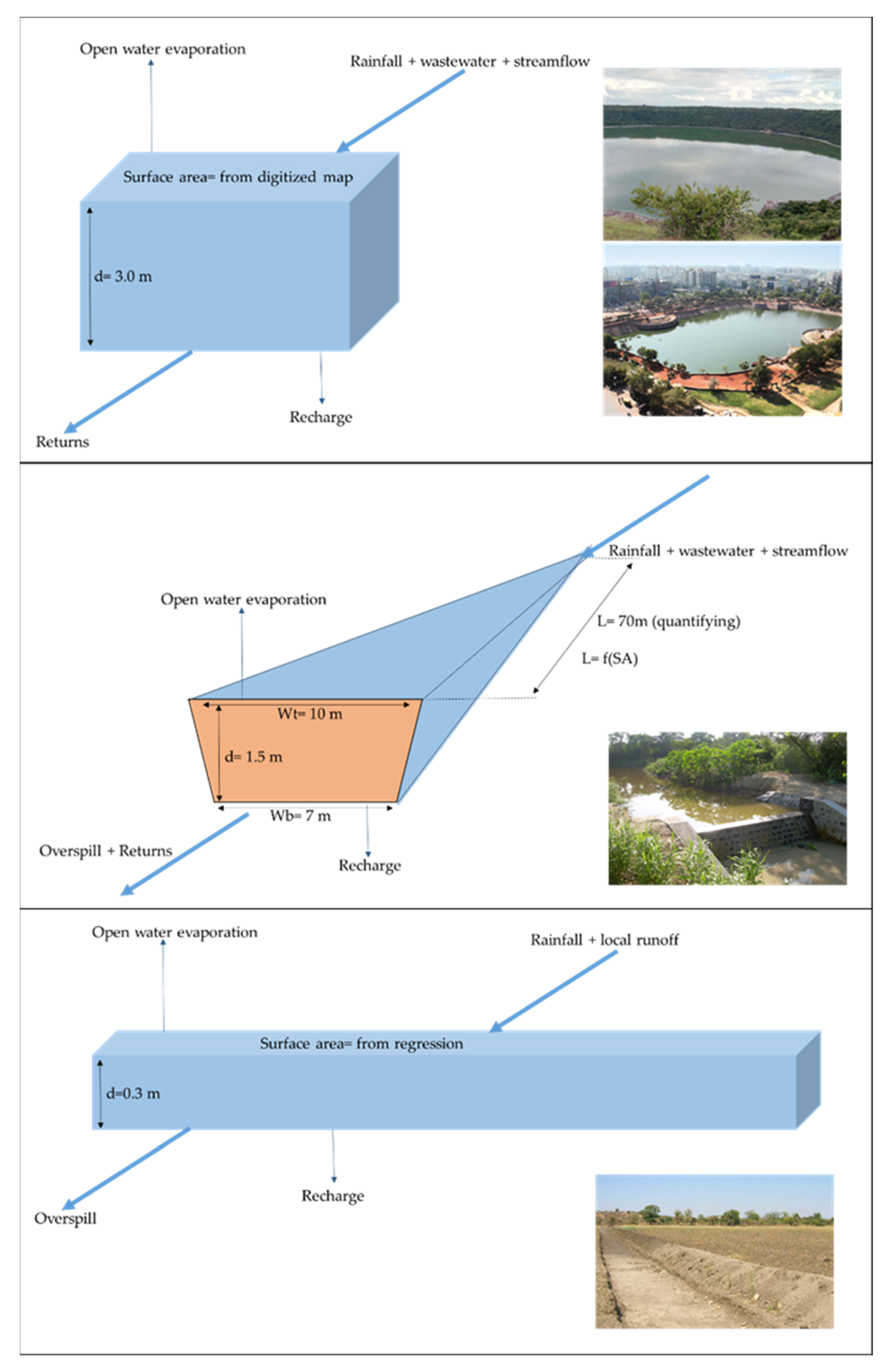
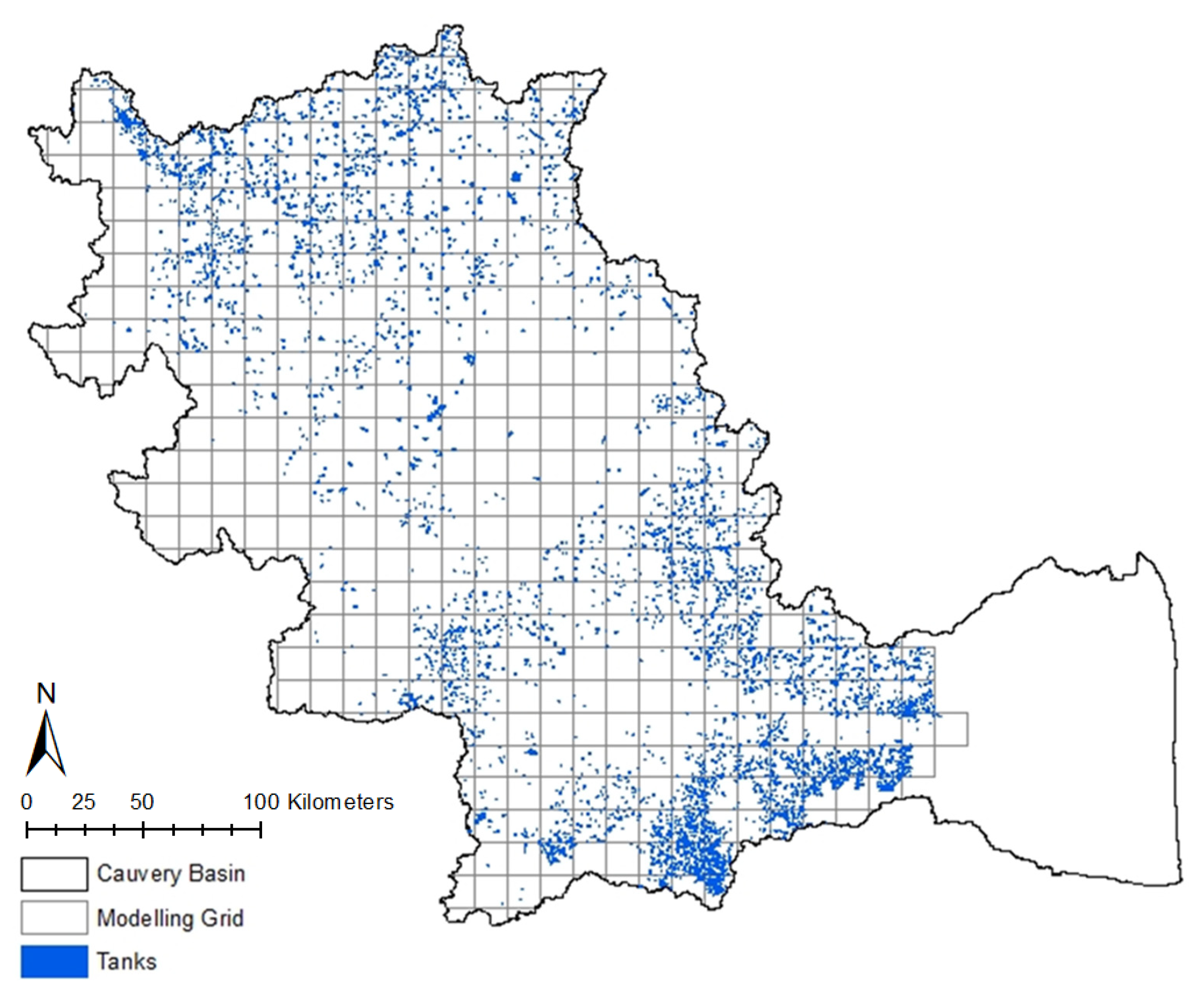
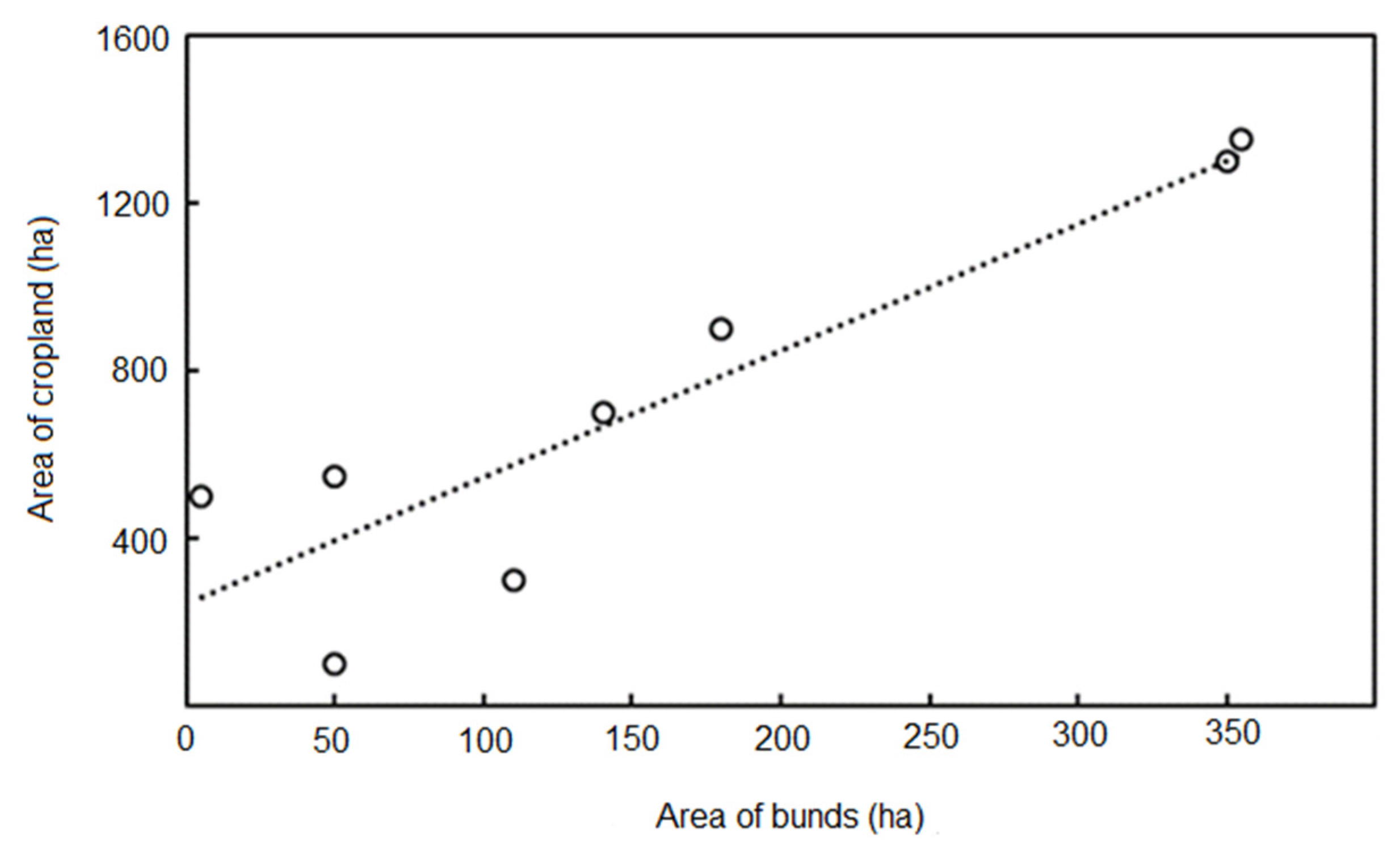
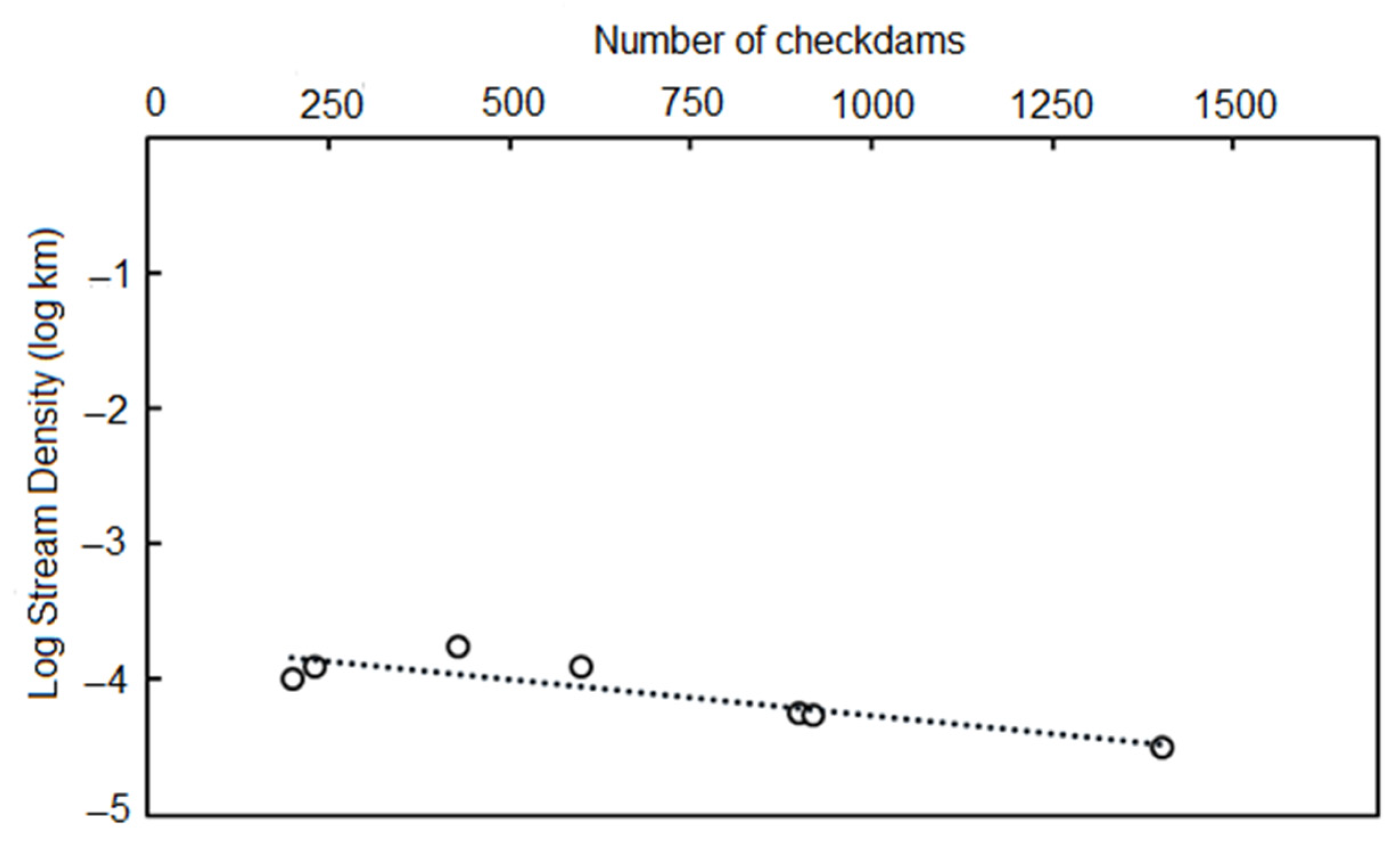
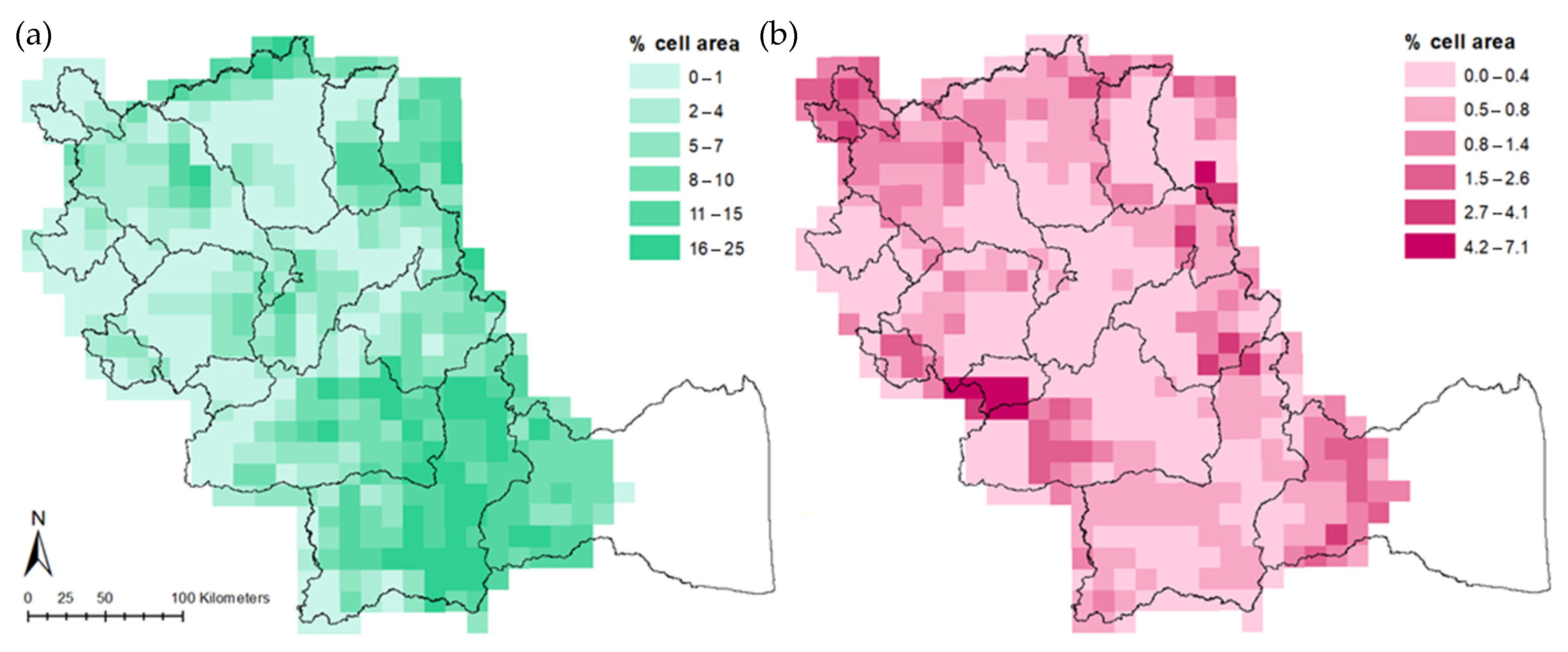


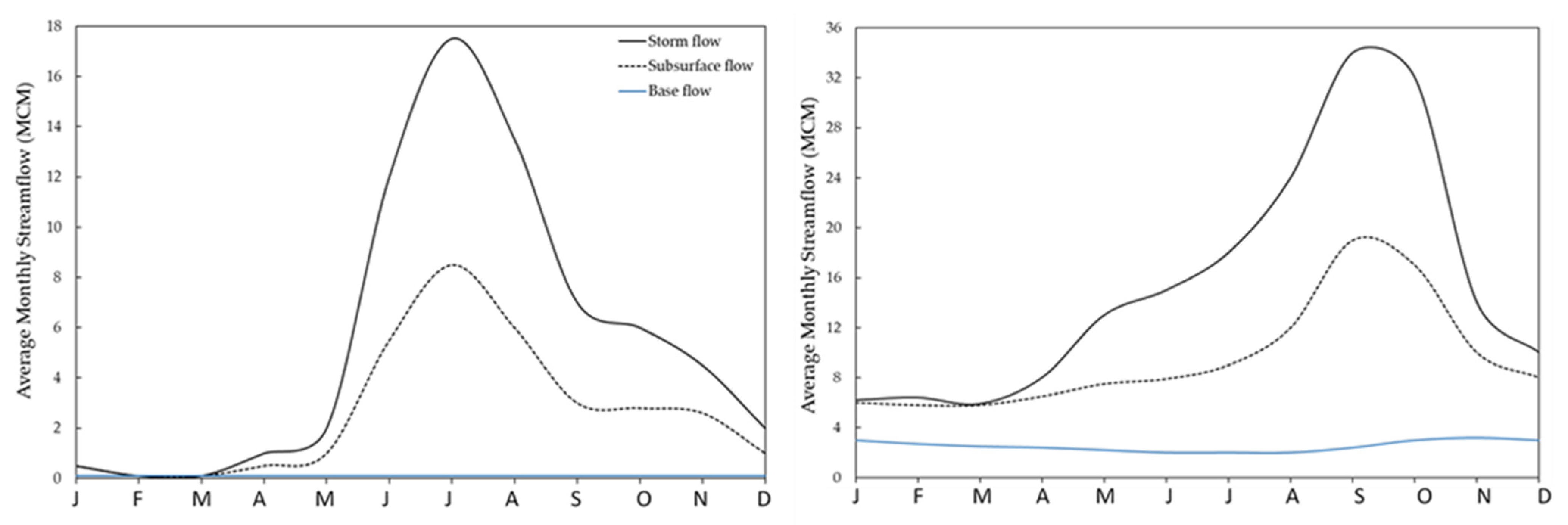
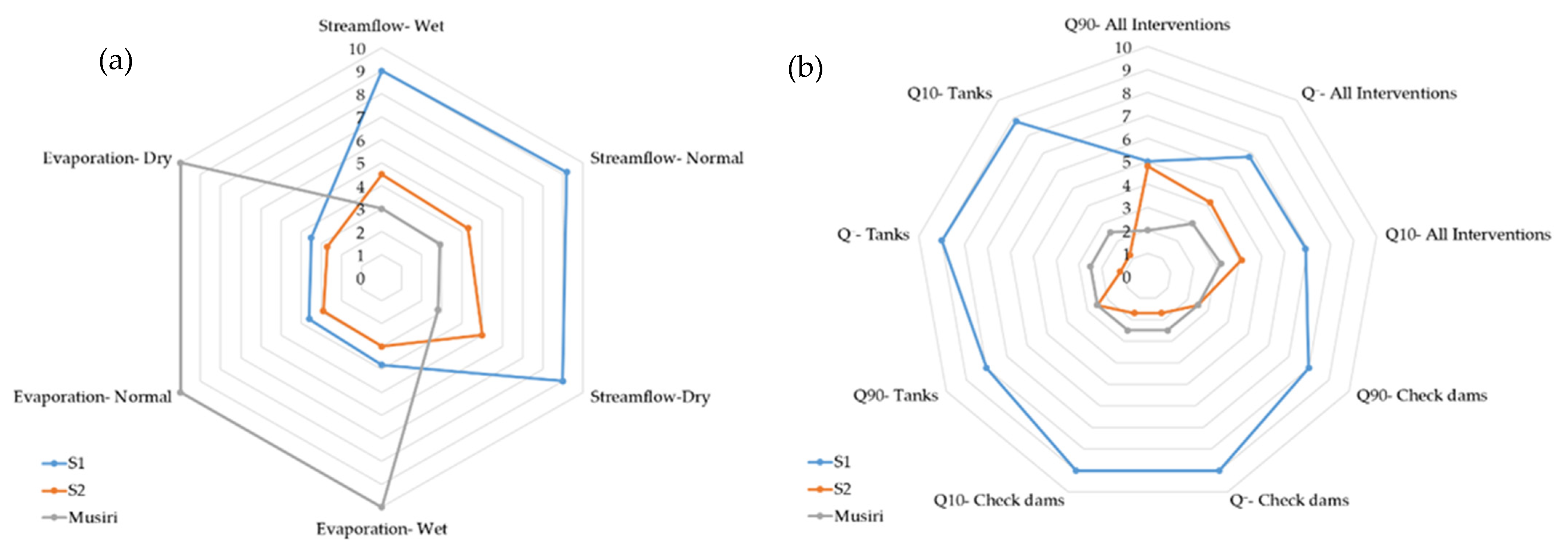
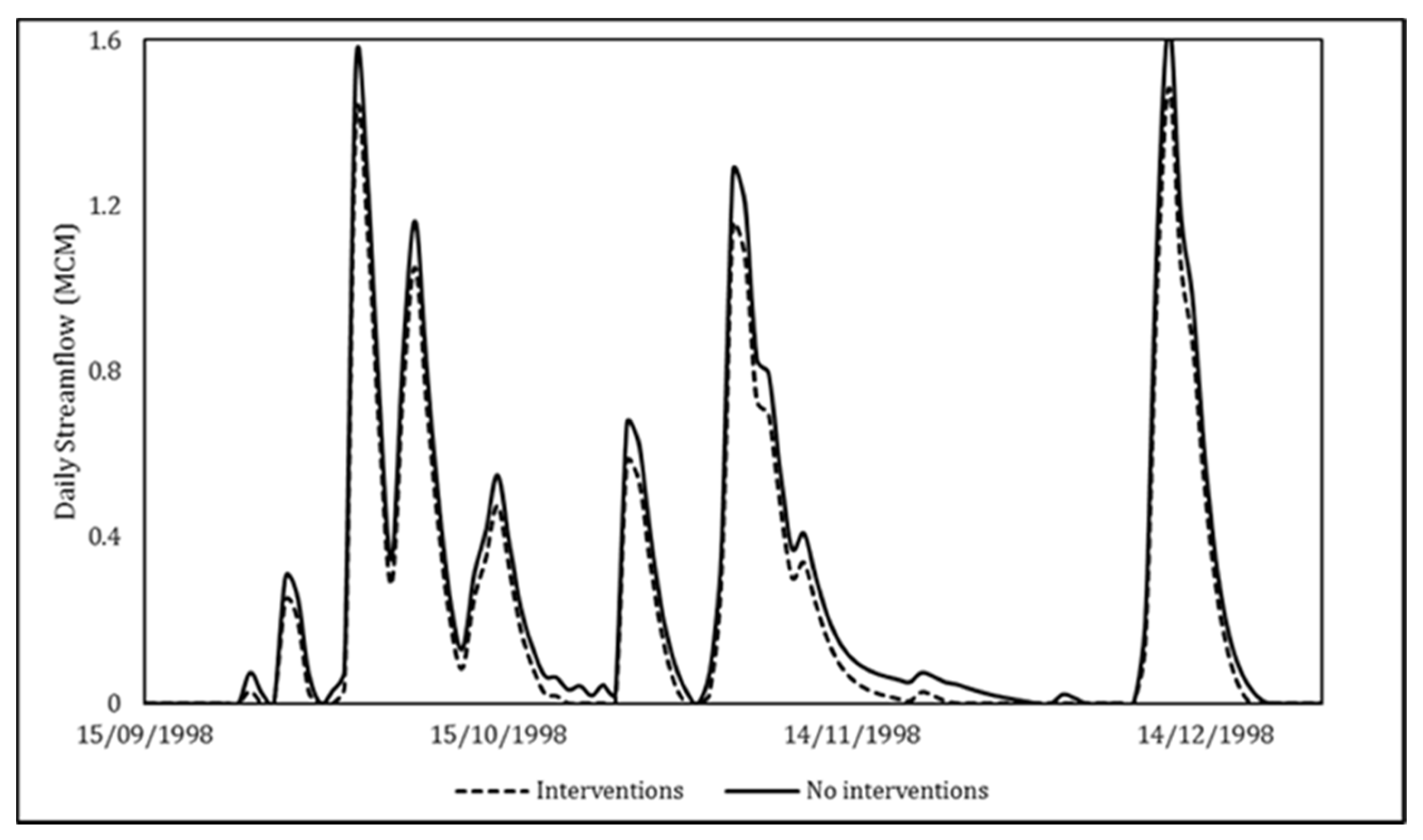
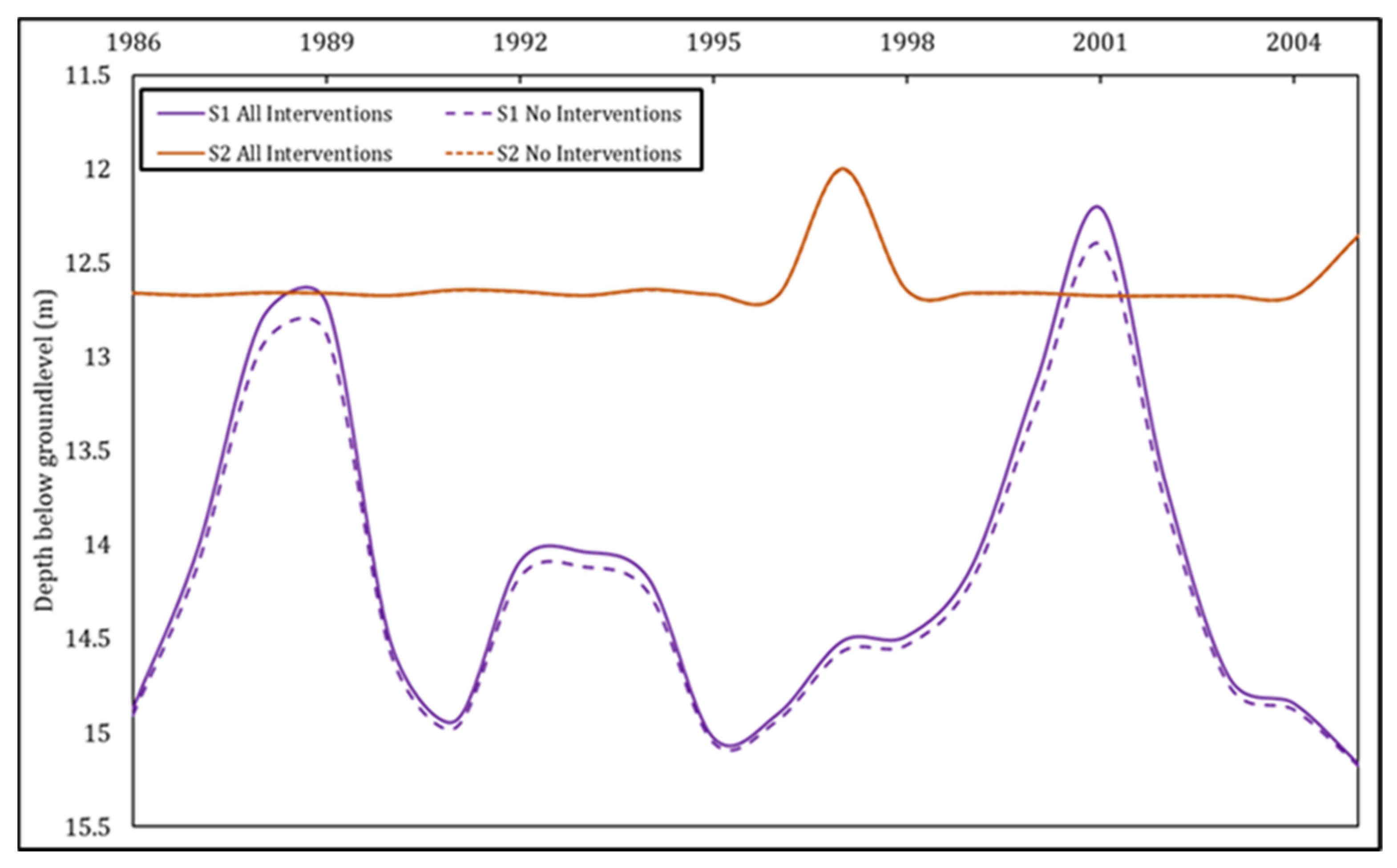
| Sub-Catchment Number | MAP (mm) | Area (km2) | Rainfall Period | Flow Characteristics | Period of No Streamflow in Main Channel (Days per Year) |
|---|---|---|---|---|---|
| S1 | 864 | 2660 | March–January | Non-Perennial | 30 < Tnoflow < 60 |
| S2 | 867 | 3120 | March–January | Perennial | 0 < Tnoflow < 3 |
| Sub-Catchment | Total Annual Precipitation (mm) | Reduction in Flows Days with the Inclusion of Interventions | ||||
|---|---|---|---|---|---|---|
| Normal Year (1998) | Dry Year (2002) | Wet Year (2005) | Normal Year (1998) | Dry Year (2002) | Wet Year (2005) | |
| S1 | 507 | 382 | 668 | 14 | 25 | 3 |
| S2 | 1874 | 656 | 2085 | 2 | 4 | 3 |
| Musiri | 1341 | 685 | 1413 | 0 | 0 | 0 |
Publisher’s Note: MDPI stays neutral with regard to jurisdictional claims in published maps and institutional affiliations. |
© 2021 by the authors. Licensee MDPI, Basel, Switzerland. This article is an open access article distributed under the terms and conditions of the Creative Commons Attribution (CC BY) license (https://creativecommons.org/licenses/by/4.0/).
Share and Cite
Horan, R.; Wable, P.S.; Srinivasan, V.; Baron, H.E.; Keller, V.J.D.; Garg, K.K.; Rickards, N.; Simpson, M.; Houghton-Carr, H.A.; Rees, H.G. Modelling Small-Scale Storage Interventions in Semi-Arid India at the Basin Scale. Sustainability 2021, 13, 6129. https://doi.org/10.3390/su13116129
Horan R, Wable PS, Srinivasan V, Baron HE, Keller VJD, Garg KK, Rickards N, Simpson M, Houghton-Carr HA, Rees HG. Modelling Small-Scale Storage Interventions in Semi-Arid India at the Basin Scale. Sustainability. 2021; 13(11):6129. https://doi.org/10.3390/su13116129
Chicago/Turabian StyleHoran, Robyn, Pawan S. Wable, Veena Srinivasan, Helen E. Baron, Virginie J. D. Keller, Kaushal K. Garg, Nathan Rickards, Mike Simpson, Helen A. Houghton-Carr, and H. Gwyn Rees. 2021. "Modelling Small-Scale Storage Interventions in Semi-Arid India at the Basin Scale" Sustainability 13, no. 11: 6129. https://doi.org/10.3390/su13116129
APA StyleHoran, R., Wable, P. S., Srinivasan, V., Baron, H. E., Keller, V. J. D., Garg, K. K., Rickards, N., Simpson, M., Houghton-Carr, H. A., & Rees, H. G. (2021). Modelling Small-Scale Storage Interventions in Semi-Arid India at the Basin Scale. Sustainability, 13(11), 6129. https://doi.org/10.3390/su13116129






